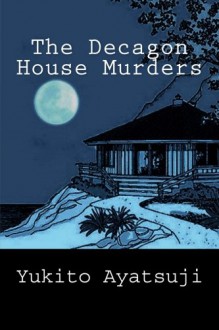
Have to say that in the end I was disappointed. You tell me that this book is a homage to "And Then There Were None" and it ends up just being kind of a mess with an ending that was nothing like that book. It didn't help that Ayatsuji had some of the book following two other characters so you don't stay on the island with the characters who are being picked off one by one. I do like that we were given a glossary in the end to understand some of the words being used in this book.
"The Decagon House Murders" is a bit of a convoluted tale. The book starts off with us in the murderer's POV. We know that he or she has something up their sleeve to make people pay for what they did. Then we transitioned over to a group of college aged students who are making their way to the Decagon House. The students plan to stay on an uninhabited island for a week. A brutal murder and apparent suicide took place there six months ago and due to this the students think it would be perfect for them to go and get away to.
All of the students belong to a mystery group at their university and they have taken the names of famous mystery writers. We have the following: Agatha, Van, Leroux, Orczy, Ellery, Carr and Poe. While they are away on the island, a former member of the mystery group, Kawaminami receives a letter accusing him of being behind the murder of a former member named Chiori. We find out that she was a shy young women who died of a heart attack brought upon due to alcohol poisoning. Kawaminami starts to try to figure out who could have sent the letter and figures out ties that Chiori has to the island that the group has just departed for.
I have to say that I didn't get a chance to get a handle on anyone. When the group on the island starts to get picked off one by one by the murderer it just started to feel anti-climatic. I liked how Christie did it via her book and how they were all sent to die based on a rhyme. This felt a little too clumsy. It didn't help that the book jumps back and forth between the murders on the island and Kawaminami's investigation with an older man he meets. I think that distracted from the overall tenor of the book and it felt a bit like we had Ayatsuji trying to throw in a bit of Arthur Conan Doyle and have a Sherlock and Watson on the scene.
The writing was okay, as I said earlier it was great to get the glossary in the book describing things. However, the flow wasn't that great. I had a hard time with the second investigation going on since it just felt really fake to me. And then it made zero sense with what we know was going on, on he island.
The setting of the island and the Decagon House were intriguing. I liked the history behind it being built and how lonesome it must have been. Ayatsuji provides some diagrams which were helpful to show where everyone is staying at and also at one point where a body is found.
The ending did have a cool twist, but I had a hard time buying it. It didn't really work I think in the end. And then the reason behind the murder felt very fake to me. It just seemed like a reason for the murderer to do what they did. We get a reveal about all of the murders and how they happened and it felt like that bit got written before the initial set up of the book.
A nice look at a Japanese golden age mystery novel. I definitely enjoyed "The Tokyo Zodiac Murders" more.


 Log in with Facebook
Log in with Facebook 






